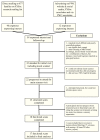Autism in Fragile X Syndrome; A Functional MRI Study of Facial Emotion-Processing
- PMID: 31861230
- PMCID: PMC6947308
- DOI: 10.3390/genes10121052
Autism in Fragile X Syndrome; A Functional MRI Study of Facial Emotion-Processing
Abstract
Fragile X syndrome (FXS) is the most common inherited cause of intellectual disability and autism spectrum disorder, and among those with fragile X syndrome, approximately 1/3rd meet a threshold for an autism spectrum disorder (ASD) diagnosis. Previous functional imaging studies of fragile X syndrome have typically focused on those with fragile X syndrome compared to either neurotypical or autism spectrum disorder control groups. Further, the majority of previous studies have tended to focus on those who are more intellectually able than is typical for fragile X syndrome. In this study, we examine the impact of autistic traits in individuals with fragile X syndrome on a paradigm looking at facial emotion processing. The study included 17 individuals with fragile X syndrome, of whom 10 met criteria for autism as measured by the Autism Diagnostic Observation Schedule (ADOS). Prior to the scan, participants rehearsed on a mock scanner to help acclimatize to the scanner environment and thus allow more severely affected individuals to participate. The task examined the blood-oxygen-level-dependent (BOLD) response to fearful and neutral faces taken from the Ekman faces series. Individuals in the autism group had a region of significantly reduced activity centered on the left superior temporal gyrus, compared to those with FXS alone, in response to the fearful faces. We suggest that autism in individuals with fragile X syndrome is associated with similar changes in the neurobiology of facial emotion processing as seen in idiopathic autism.
Keywords: autism; emotion-processing; fragile X syndrome; functional imaging.
Conflict of interest statement
The authors declare no conflict of interest. The funders had no role in the design of the study; in the collection, analyses, or interpretation of data; in the writing of the manuscript, or in the decision to publish the results.
Figures




Similar articles
-
Differentiating social preference and social anxiety phenotypes in fragile X syndrome using an eye gaze analysis: a pilot study.J Neurodev Disord. 2019 Jan 21;11(1):1. doi: 10.1186/s11689-019-9262-4. J Neurodev Disord. 2019. PMID: 30665413 Free PMC article.
-
Implicit Discrimination of Basic Facial Expressions of Positive/Negative Emotion in Fragile X Syndrome and Autism Spectrum Disorder.Am J Intellect Dev Disabil. 2015 Jul;120(4):328-45. doi: 10.1352/1944-7558-120.4.328. Am J Intellect Dev Disabil. 2015. PMID: 26161470
-
Autism Spectrum Disorder Symptoms in Infants with Fragile X Syndrome: A Prospective Case Series.J Autism Dev Disord. 2017 Jun;47(6):1628-1644. doi: 10.1007/s10803-017-3081-9. J Autism Dev Disord. 2017. PMID: 28281129 Free PMC article.
-
Autism Symptoms in Fragile X Syndrome.J Child Neurol. 2017 Sep;32(10):903-909. doi: 10.1177/0883073817712875. Epub 2017 Jun 15. J Child Neurol. 2017. PMID: 28617074 Review.
-
Melatonin as a Novel Interventional Candidate for Fragile X Syndrome with Autism Spectrum Disorder in Humans.Int J Mol Sci. 2017 Jun 20;18(6):1314. doi: 10.3390/ijms18061314. Int J Mol Sci. 2017. PMID: 28632163 Free PMC article. Review.
Cited by
-
Autism spectrum disorder in females with fragile X syndrome: a systematic review and meta-analysis of prevalence.J Neurodev Disord. 2021 Jul 23;13(1):28. doi: 10.1186/s11689-021-09362-5. J Neurodev Disord. 2021. PMID: 34294028 Free PMC article.
-
Calcium channelopathies and intellectual disability: a systematic review.Orphanet J Rare Dis. 2021 May 13;16(1):219. doi: 10.1186/s13023-021-01850-0. Orphanet J Rare Dis. 2021. PMID: 33985586 Free PMC article.
-
Task-based functional MRI challenges in clinical neuroscience: Choice of the best head motion correction approach in multiple sclerosis.Front Neurosci. 2022 Dec 7;16:1017211. doi: 10.3389/fnins.2022.1017211. eCollection 2022. Front Neurosci. 2022. PMID: 36570849 Free PMC article.
References
-
- Crawford D.C., Meadows K.L., Newman J.L., Taft L.F., Pettay D.L., Gold L.B., Hersey S.J., Hinkle E.F., Stanfield M.L., Holmgreen P., et al. Prevalence and phenotype consequence of FRAXA and FRAXE alleles in a large, ethnically diverse, special education-needs population. Am. J. Hum. Genet. 1999;64:495–507. doi: 10.1086/302260. - DOI - PMC - PubMed
Publication types
MeSH terms
LinkOut - more resources
Full Text Sources
Medical
Miscellaneous

